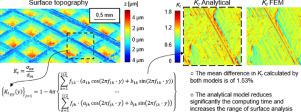当前位置:
X-MOL 学术
›
Int. J. Mech. Sci.
›
论文详情
Our official English website, www.x-mol.net, welcomes your
feedback! (Note: you will need to create a separate account there.)
An analytical approach to calculate stress concentration factors of machined surfaces
International Journal of Mechanical Sciences ( IF 7.1 ) Pub Date : 2021-01-01 , DOI: 10.1016/j.ijmecsci.2020.106040 I. Perez , A. Madariaga , P.J. Arrazola , M. Cuesta , D. Soriano
International Journal of Mechanical Sciences ( IF 7.1 ) Pub Date : 2021-01-01 , DOI: 10.1016/j.ijmecsci.2020.106040 I. Perez , A. Madariaga , P.J. Arrazola , M. Cuesta , D. Soriano

|
Abstract Machining operations affect the properties of the final surface layer, and these can impact on its functional performance, particularly on fatigue behaviour. Among the properties of the machined surface, surface topography is one major parameter affecting fatigue behaviour. The literature review has demonstrated that stress concentration factors Kt of the surface provide a more reliable estimation of the impact on the fatigue behaviour of machined components. Finite Element (FE) simulations can accurately calculate the stress concentration factor of machined surfaces, but they incur a high computational cost. Recent advances have shown that analytical models can reliably determine stress concentration factors of 2D roughness profiles. However, analytical models that predict stress concentration factors of 3D surface topographies are still lacking. This paper is aimed at developing an analytical method to calculate the stress concentration factor Kt of 3D surfaces generated by machining operations. To validate the model, a specimen of 7475-T7351 aluminium alloy was face milled and its surface topography was characterised using an Alicona IFG4 profilometer. Stress concentration factors were calculated in the selected surface regions using the proposed analytical model, and later compared to results obtained by FE simulations. The mean difference in the stress concentration factor Kt calculated by the proposed analytical and FE models is of 1.53%. Importantly, the developed analytical model reduces the computing time by 3000 times compared to FE models, and enables the analysis of larger surfaces.
中文翻译:

一种计算加工表面应力集中系数的分析方法
摘要 加工操作会影响最终表面层的特性,这些特性会影响其功能性能,尤其是疲劳行为。在加工表面的特性中,表面形貌是影响疲劳行为的主要参数之一。文献综述表明,表面的应力集中系数 Kt 可以更可靠地估计对机加工部件疲劳行为的影响。有限元 (FE) 模拟可以准确计算加工表面的应力集中系数,但会产生很高的计算成本。最近的进展表明,分析模型可以可靠地确定二维粗糙度轮廓的应力集中因子。然而,仍然缺乏预测 3D 表面形貌应力集中因素的分析模型。本文旨在开发一种分析方法来计算由加工操作生成的 3D 表面的应力集中系数 Kt。为了验证模型,对 7475-T7351 铝合金试样进行面铣,并使用 Alicona IFG4 轮廓仪表征其表面形貌。使用建议的分析模型在选定的表面区域计算应力集中系数,然后与有限元模拟获得的结果进行比较。由建议的分析模型和有限元模型计算的应力集中系数 Kt 的平均差异为 1.53%。重要的是,与有限元模型相比,开发的分析模型将计算时间减少了 3000 倍,
更新日期:2021-01-01
中文翻译:

一种计算加工表面应力集中系数的分析方法
摘要 加工操作会影响最终表面层的特性,这些特性会影响其功能性能,尤其是疲劳行为。在加工表面的特性中,表面形貌是影响疲劳行为的主要参数之一。文献综述表明,表面的应力集中系数 Kt 可以更可靠地估计对机加工部件疲劳行为的影响。有限元 (FE) 模拟可以准确计算加工表面的应力集中系数,但会产生很高的计算成本。最近的进展表明,分析模型可以可靠地确定二维粗糙度轮廓的应力集中因子。然而,仍然缺乏预测 3D 表面形貌应力集中因素的分析模型。本文旨在开发一种分析方法来计算由加工操作生成的 3D 表面的应力集中系数 Kt。为了验证模型,对 7475-T7351 铝合金试样进行面铣,并使用 Alicona IFG4 轮廓仪表征其表面形貌。使用建议的分析模型在选定的表面区域计算应力集中系数,然后与有限元模拟获得的结果进行比较。由建议的分析模型和有限元模型计算的应力集中系数 Kt 的平均差异为 1.53%。重要的是,与有限元模型相比,开发的分析模型将计算时间减少了 3000 倍,











































 京公网安备 11010802027423号
京公网安备 11010802027423号